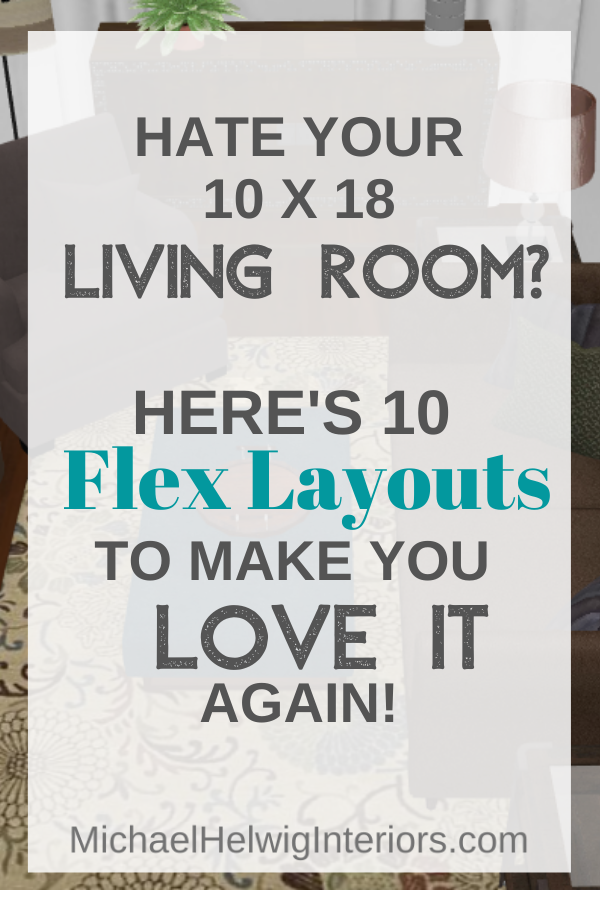Small living rooms can be a P.I.T.A. Especially long narrow ones. It often feels like you’re playing Tetris; trying to maneuver a beefy couch next to a an even beefier chair. You lug and push until you’re too exhausted to care and you just leave your furniture any old way to avoid more stress. After a couple of weeks of “living with it,” you look at it and you know there’s a better way to arrange it so, on you go again, lugging and pushing, micro-positioning and tweaking angles ever-so-slightly…
Before you throw your hands up in disgust, there’s a better way to tackle this job of laying out your living room furniture. It will take a bit of out of the box planning and the use of a few designer standard practices, but what you’ll learn is a thoughtful way to go about arranging your living room.
First a little preliminary planning
1. Have a plan for your space: Before you spend your energy physically moving your stuff around, make a list of requirements your room needs to fulfill. Things like,
the number of seats you need for your family.
How durable you need your furniture to be.
Where’s the focal point? (Is it the Entertainment console with the TV, the fireplace, a view outside? Is it the TV over the fireplace?)
Where’s the majority of attention going to be?
Make a note about how you need the room to function as a flexible space: will you need a dining area?
Will you need an office space?
Do you want a reading nook?
2. Embrace some designer standards: Once you have a plan in place for how you intend to use your space, keep a few of these helpful hints in mind.
Sofas – typically go on the longest unobstructed wall. This means the wall that has the longest run without a doorway, bump out or unmovable architectural feature like built-in shelving or a fireplace, etc.
Consider featuring the height of the room. Taller items, like tall plants, shelving, blanket ladders, statues, etc. make the room feel taller. This is because they bring the eye up and varied heights add dimension and interest. Another way to do this is to bring your window treatment rods all the way up to the ceiling or crown molding. Curtains are a layer in front of the wall and dimension crates volume. Having then hardware all the way to the ceiling amplifies that volume.
3. Think Multi-function: As you’re planning the use of your space, keep in mind how a few multi-purpose pieces like storage ottomans, parsons tables can enhance the space.
Furniture that can do double or triple duty but, take up the same amount of space will be very helpful.
A storage ottoman can store board games, blankets, toys, papers, books. It can also serve as extra seating if necessary.
A Parsons table can be a sofa table, entry hall table, a buffet, a desk. Multi-use furniture can be a game changer for a small living room.
Attention to details like these will not only help you create a space that is functional, it will also help you make your home look rich and luxurious.
The Room Layout
Here’s the context of this space: It’s an 18’ long x 10’ wide living room, long and narrow. It’s actually based on my own living room, minus the fireplace. I threw that in to make it a tad more challenging…
There’s a separate entry foyer that is off to the left and it is not part of the core 18’x10’ living room. There’s a small half wall, knee wall, that separates the entry from the living room and there’s a coat closet opposite the front door.
In the living room, there’s an open kitchen doorway, a fireplace, and 4 widows: two flanking the fireplace and two on the perpendicular 10’ wall.
The other challenge is the 10’ width because it’s too narrow to comfortably accommodate most generous sized seating or case goods.
It’s a challenging room because the longest wall is obstructed by the kitchen doorway. This means that you can’t center the furniture on the fireplace and the wall at the same time, you’ll always have to choose one over the other.
So, the fireplace, perpendicular entry ways and unbalanced windows make this a tricky room to layout. It’s not impossible but, it will take more planning to get it right. And the windows are two different sizes. There’s 2 tall windows flanking the fireplace and 2 short awning windows placed high up on the perpendicular wall. That automatically throws the visual balance off before anything is even in the room.
So, if you hate your 12 x 18 living room, here’s 10 flex layouts to make you love it again.
Work, Eat, Live
This first space has triple function. There’s a small dining area, a living room and behind the sectional, there’s a small desk serving as an office area.
First, the table is 36” round with a pedestal base. No table legs will provide more leg room and the ability to push the chairs all the way in when not in use.
The sectional is 98” x 98” with just under 2’ of walking space on the fireplace side and that’s plenty of room to move comfortably. You typically need 18” to walk around furniture comfortably and this space is 22”.
The desk is thin, 49 inches long by 25 inches deep. It’s a great size, not too big and it can easily double as a sofa table when not office use.
Not having an end table on that side of the sectional, the desk/sofa table is ideal for putting a lamp on for extra light and having a spot to place a drink or book when seated on that end of the sectional.
As you can see, there is plenty of space at the kitchen entry and foyer to move into the room comfortably.
2. Symmetrical Flex Space
If you’re working from home these days, having a flex space that gives you a dedicated desk in a small home is essential. This layout allows for that space to work as a proper desk but, also double as a credenza if needed.
It can serve as a place to set up a bar for company or to arrange snacks for a party. It can also be a place to display accessories or to style a vignette when not being used as a work surface.
The rug centers the seating arrangement even though it cannot be centered on the fireplace because of the kitchen doorway. Sometimes you work with the architectural elements as they are and you adapt the layout.
The symmetrical living room layout is a classic: two chairs perpendicular to the long sofa. There’s a couple of matching end tables to flank the sofa giving every seat access to a surface for drinks or plates, etc.
Notice how the chairs slightly overlap the end tables next to the sofa. The tables are pushed toward the back of the sofa so that the drawers on the end tables can open.
3. Dedicated Living Room #1
Dedicated living room means that it is only a living room space, not a flex space.
This configuration shows a large 90” sofa that is 38” deep, so that is a large-scale sofa.
The chair in the upper left is configured for reading with a ceiling light for illumination. This could be considered a reading nook or reading corner.
The two matching accent chairs are configured in a conversation style, angled in toward each other and perpendicular to the sofa.
This layout is also centered on the area rug instead of the fireplace due to the kitchen entry. Rugs are a great way to anchor a seating arrangement and they help to define an area especially when the immovable features in a room don’t allow for natural centering. Personalized doormats at the entry can similarly set the tone for the space, providing a welcoming and tailored first impression.
From this vantage point you can see that there is plenty of space to walk around in the room. The primary function is for reading and conversing. There is a TV above the fireplace, in each of these spaces as well.
Here’s the opposite vantage point with the reading chair and handing pendant for lighting.
You’ll notice that the half round table is in all the renders because the entry way only has a couple of inches on the closet wall side and the space isn’t useful for another type of table.
The rounded front allows for adequate surface but also provides a tapered edge so it doesn’t impede the doorway.
4. Large Chaise Sectional
This is a large footprint sectional. The layout gives you the most amount of upholstered seating in the form of a sectional. There’s a built-in end table on the kitchen side arm of the sectional. It’s an ideal for a spot to place a drink and a table lamp.
To provide balance on the other side, I installed a thin 19” wide x 50” long sofa table. This is another great spot to place a table lamp for even lighting.
The accent chair is placed perpendicular to the “arm” of the sectional, overlapping the table to open the entry space from the kitchen. The large coffee table acts as a surface for entertaining and can be shifted from one side of the sectional to the other.
There’s a low bookcase next to the knee wall for display and to balance the fireplace wall against the large footprint of the sectional.
This vantage point shows the sectional and gives you an idea of how large it is.
As you can see, the room is easy to navigate but, it is not at all able to be reconfigured. Once you decide that this is your set up, the furniture stays where it is because there is no other way the sectional can layout.
5. Living and Office Space #2
Here is another idea with a flexible workspace in the corner by the knee wall opposite a traditional conversation grouping.
The small-scale sofa is 78” wide with a small accent chair perpendicular to it and two small bucket seat accent chairs configured in a conversational arrangement.
Every seat has a surface top to use: the two end tables and the shared round accent table between them.
The rectangular ottoman provides a nice place to put your feet up and the tray on top gives you a nice option for serving drinks and snacks.
An area to pay attention to, for this arrangement, is the space between the chair and the corner of the desk.
Carefully choosing these two pieces will make a huge difference for how comfortable the navigation of the room is.
You don’t want to choose a chair with big round arms that take up 3 or more inches. A nice tapered arm reduces the footprint and makes it easier to get around.
The desk cannot be deep because it cannot project out further into the room and there isn’t enough space toward the wall to fit a chair if it’s deeper.
Remember, you need at least 18” to move comfortably between furniture. If you can get a bit more space, even better.
6. U-Shaped Sectional
This layout is similar to the chaise sectional because it cannot be re-positioned in a different way. But, if a massive amount if seating is what you require, this is a great option.
The longest side is 126”, or 10’ 5”. The shorter side is 102” which only leave 1 and a half feet on the fireplace side.
There also isn’t space for an end table on the fireplace wall, so you have to be okay using a tray on the cocktail ottoman or changing that piece out for a solid surface cocktail table like wood, metal or stone.
On that same note, you could easily change the shape of the cocktail ottoman to square or rectangle because of the size of the seating area.
This layout not ideal if you want to create different zones like a workspace or eat-in area.
The small blue storage bench gives the space a little more flexibility and doubles as extra seating in a pinch.
7. Sofa, Loveseat, Chair
If a classic furniture layout is something you’re interested in, here’s a great option. The width of the room is not wide enough for a full size sofa so this layout gives extra seating with a studio size sofa sand loveseat.
The sofa is 74 inches wide and the loveseat is 50 inches, small for sure but, adequate. The opposite corner has a larger single chair ½ that balances out the other side.
There is a large credenza on the far end of the room to add storage and functionality. It’s a larger footprint and it’s a great place for a lamp and some accessories too.
From here you can see that there isn’t a ton of room between the fireplace wall and the loveseat but, it’s plenty of room to get behind the loveseat to open and close the drapes and water the plant.
I chose to have a floor lamp behind the chair. If you decided to install a pendant light, you could move the chair closer to the corner for a bit more room, but this is an ideal amount of space for this side either way.
8. Small Chaise Sectional
Much like the large chaise sectional from earlier, this layout gives you a comfortable configuration and the ability to put your feet up. The difference between this smaller footprint and the larger one is there is room for a bookcase on the 10’ wall.
That can add a lot more functionality and depth to the space. Now you have storage and display surfaces that can really help you showcase your treasures.
I included the bench to give a bit more storage and additional overflow seating.
The round ottoman allows for easy movement throughout the space and a place to put your feet up, to provide extra seating or a spot for a tray.
This particular chaise side is quite long but there’s a lot of small scale sectionals that have shorter chaise options if space is more of a concern.
Tip: Always make sure the chaise is reversible, meaning it can be on the left or right side of the sectional. If it is not reversible, you need to make sure it is affixed to the side that will be most appropriate for the traffic flow in your small living room. You don’t want a chaise sticking out in the main traffic area. You’ll get sick of walking around it quick.
9. The Balanced Conversation Layout
The Sofa is centered on the rug and the two chairs opposite are angled into conversation configuration.
Small round occasional tables on the sides of the chairs provide a place to put down a drink or book.
The credenza on the 10’ wall balances out the end and gives you ample space for closed storage and surface display.
The bookcase next to the knee wall allows for display and storage.
10. Sophisticated and Comfortable Work & Living Space
This last space is all about having a great spot to sack out on movie night and the ability to catch up a good book in the corner. The living space is balanced nicely with the small work desk next to the knee wall.
You’ve got a centered sofa on the area rug, flanked by two end tables and an ottoman top, rectangular cocktail table for utility and comfort.
Although it isn’t maxed out for seating, a stylish Chesterfield sofa always adds a level of sophistication to a space and both main seating pieces offer a generous size for comfort. Sometimes that’s the most important function of all.
Well, that’s the story, 10 flex layouts for your 10 x 18 living room. I’d love to hear if you have a favorite option. Leave a comment below and tell me all about it.
If you need a bit more help here’s another post about the best practices for arranging a small and narrow room.
And if you’re just beginning the planning phase for your space, this post on what to know for your living room makeover will keep you on track with figuring out what you need, where to save and where to splurge. It’s a great resource for any size living room or any room for that matter!
Thanks for taking the time to read and I will catch you here next week!
“This man is a plant shaman. He not only designs beautiful rooms, he’s got a green thumb that works like magic! My peace palm never looked better.”
“Michael Helped me to get my home office in magazine ready form. Thank you a million times for helping me figure this room out. It’s now my favorite room!”
Michael is Principal designer and blogger at Michael Helwig Interiors in beautiful Buffalo, New York. Since 2011, he’s a space planning expert, offering online interior e-design services for folks living in small homes, or for those with awkward and tricky layouts. He’s a frequent expert contributor to many National media publications and news outlets on topics related to decorating, interior design, diy projects, and more. Michael happily shares his experience to help folks avoid expensive mistakes and decorating disappointments. You can follow him on Pinterest, Instagram and Facebook @interiorsmh.







